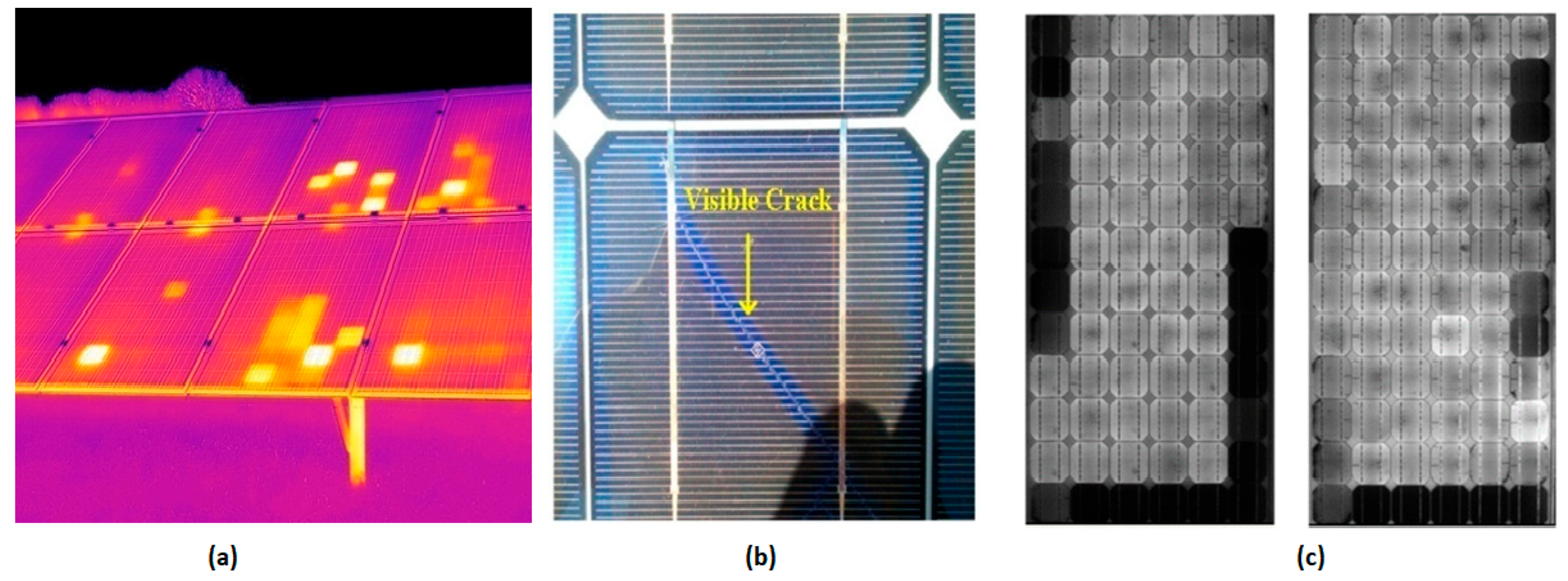Faults, Failures, Reliability, and Predictive Maintenance of Grid-Connected Solar Systems: A Comprehensive Review
Abstract
1. Introduction
1.1. Common Faults and Failures in Grid-Connected Solar Systems
- Module Degradation: Issues such as micro-cracks, delamination, encapsulate discoloration, and hot spots degrade PV modules over time, reducing power output and potentially leading to permanent damage.
- Inverter Failures: Inverters play a critical role in converting DC power from PV panels into grid-compatible AC power. However, their performance deteriorates due to thermal stress, aging, and software malfunctions, sometimes leading to complete system shutdowns [15].
- Grid-Related Issues: Voltage fluctuations, frequency variations, and regulatory constraints impact the operation of grid-tied PV systems, potentially causing grid instability if not managed properly.
- Electrical Connectivity Issues: Loose or corroded terminals, poor insulation, and inadequate grounding can result in power losses, fire hazards, and safety risks.
- Environmental and External Factors: Extreme temperature variations, humidity, dust accumulation, shading, and severe weather conditions (e.g., hailstorms and lightning strikes) accelerate degradation and increase failure risks. Hybrid systems incorporating battery storage also face challenges such as battery aging, capacity loss, and thermal runaway, which must be addressed to ensure system stability and longevity [16].
1.2. Role of Predictive Maintenance in Enhancing Reliability
- Real-Time Monitoring and Data Analytics: Supervisory Control and Data Acquisition (SCADA) systems and IoT-enabled sensors continuously collect operational data. Advanced analytics tools identify deviations from normal performance, allowing for early fault detection [19].
- AI and Machine Learning-Based Fault Detection: AI-driven models analyze historical and real-time data to predict potential failures, estimate remaining useful life, and suggest corrective actions [20].
- Thermal Imaging and Infrared Inspection: Thermal cameras detect temperature anomalies and hotspots in solar panels, which indicate issues such as cell degradation and bypass diode failures [21].
- Drone-Based Aerial Inspections: High-resolution imaging and thermal scans from drones enable rapid fault detection at the module level, reducing inspection time and labor costs [22].
- Power Quality and Grid Stability Assessments: Advanced power monitoring systems ensure compliance with grid regulations, while also detecting anomalies that could lead to system faults or efficiency losses [23].
1.3. Reliability and Availability Analysis
2. PV System Network Configurations
3. Power Quality Impacts of Grid-Connected Solar Systems
3.1. Impact of Solar PV Systems on the Grid
3.1.1. Voltage Deviations and Harmonics Injection
3.1.2. Flicker Effects and Frequency Stability Concern
3.1.3. Reverse Power Flow Challenges
3.2. Impact of Grid on Solar PV Systems
3.2.1. The Impact of Grid Outages and Disturbances on Solar PV Systems
3.2.2. Grid Disturbances Affecting On-Grid Inverters
3.2.3. Voltage Sags/Swells and Their Influence on PV Operation
3.2.4. Sudden Grid Disconnections and Their Consequences
4. Faults and Failures in Grid-Connected Solar PV Systems
4.1. Types of Faults in Solar PV Systems
- Solar Panel Associated Faults.
- Electrical Faults: Open circuit, short circuit, ground faults.
- Inverter and Power Electronics Failures: Switching failures, overheating, and component degradation.
- Grid-Related Faults: Islanding, voltage imbalances, frequency shifts.
- Environmental and Mechanical Failures: Soiling, shading, weather-induced degradation.
4.1.1. DC-Side Faults
4.1.2. AC-Side Faults
4.1.3. Environmental and Degradation Faults
4.1.4. Solar Panels Associated Fault
4.1.5. Electrical Faults
4.1.6. Inverter and Power Electronics Failures
4.1.7. Grid-Related Faults
4.1.8. Environmental and Mechanical Failures
4.2. Impact of Faults on System Performance and Safety
4.2.1. Effect on Performance Output
4.2.2. Concerns on Safety
4.2.3. Faults and Maintenance in Solar PV Systems
5. Fault Diagnosis and Predictive Maintenance Approaches
5.1. Traditional Diagnostic Techniques
- Detailed panel inspection techniques.
- Infrared thermography for panel inspection.
- I-V curve tracing for module performance analysis.
- Ground fault detection methods.
5.1.1. Physical Panel Inspection
5.1.2. Infrared Thermography
5.1.3. I-V Curve Tracing
5.1.4. Ground Fault Detection Methods
5.2. AI and Machine Learning-Based Fault Detection
5.2.1. Data-Driven Predictive Maintenance Approaches
5.2.2. Feature Extraction and Classification Techniques for Fault Diagnosis
5.2.3. An Approach Towards Predictive Maintenance Using Data
5.2.4. Techniques of Feature Extraction and Classification Used in Fault Diagnosis
5.3. Monitoring the Physical Condition Using Digital Twins
5.4. IoT and Smart Monitoring Systems
5.4.1. Role of IoT in Real-Time Fault Detection
5.4.2. Cloud-Based Predictive Analytics for Grid-Connected Solar Plants
5.5. Fault Detection Methods for Predictive Maintenance
6. Strategies for Enhancing the Reliability of Grid-Connected Solar Systems
6.1. Quantitative Analysis Tables for PV Faults and Diagnostics
6.2. Review Methodology and Data Synthesis
7. Discussion and Future Directions
7.1. Summary of Key Findings
7.2. Opportunities and Challenges for Future Research
7.3. Recommendations for Policies and Industry to Enhance the Reliability of Grid-Integrated Solar Power Systems
8. Conclusions
Author Contributions
Funding
Institutional Review Board Statement
Informed Consent Statement
Conflicts of Interest
References
- Nwaigwe, K.; Mutabilwa, P.; Dintwa, E. An overview of solar power (PV systems) integration into electricity grids. Mater. Sci. Energy Technol. 2019, 2, 629–633. [Google Scholar] [CrossRef]
- Jiménez-Torres, M.; Rus-Casas, C.; Lemus-Zúiga, L.G.; Hontoria, L. The Importance of Accurate Solar Data for Designing Solar Photovoltaic Systems—Case Studies in Spain. Sustainability 2017, 9, 247. [Google Scholar] [CrossRef]
- Hayat, M.B.; Ali, D.; Monyake, K.C.; Alagha, L.; Ahmed, N. Solar energy—A look into power generation, challenges, and a solar-powered future. Int. J. Energy Res. 2019, 43, 1049–1067. [Google Scholar] [CrossRef]
- Du, E.; Zhang, N.; Hodge, B.-M.; Wang, Q.; Kang, C.; Kroposki, B.; Xia, Q. The role of concentrating solar power toward high renewable energy penetrated power systems. IEEE Trans. Power Syst. 2018, 33, 6630–6641. [Google Scholar] [CrossRef]
- Khan, J.; Arsalan, M.H. Solar power technologies for sustainable electricity generation—A review. Sustain. Energy Rev. 2016, 55, 414–425. [Google Scholar] [CrossRef]
- Sangswang, A.; Konghirun, M. Optimal Strategies in Home Energy Management System Integrating Solar Power, Energy Storage, and Vehicle-to-Grid for Grid Support and Energy Efficiency. IEEE Trans. Ind. Appl. 2020, 56, 5716–5728. [Google Scholar] [CrossRef]
- Zhang, C.; Xia, J.; Guo, X.; Huang, C.; Lin, P.; Zhang, X. Multi-optimal design and dispatch for a grid-connected solar photovoltaic-based multigeneration energy system through economic, energy and environmental assessment. Sol. Energy 2022, 243, 393–409. [Google Scholar] [CrossRef]
- Bamisile, O.; Acen, C.; Cai, D.; Huang, Q.; Staffell, I. The environmental factors affecting solar photovoltaic output. Renew. Sustain. Energy Rev. 2025, 208, 115073. [Google Scholar] [CrossRef]
- Sayed, A.; El-Shimy, M.; El-Metwally, M.; Elshahed, M. Reliability, Availability and Maintainability Analysis for Grid-Connected Solar Photovoltaic Systems. Energies 2019, 12, 1213. [Google Scholar] [CrossRef]
- Tawfiq, A.A.E.; El-Raouf, M.O.A.; Mosaad, M.I.; Gawad, A.F.A.; Farahat, M.A.E. Optimal Reliability Study of Grid-Connected PV Systems Using Evolutionary Computing Techniques. IEEE Access 2021, 9, 42125–42139. [Google Scholar] [CrossRef]
- Sarita, K.; Saket, R.; Khan, B. Reliability, availability, and condition monitoring of inverters of grid-connected solar photovoltaic systems. IET Renew. Power Gener. 2023, 17, 1635–1653. [Google Scholar] [CrossRef]
- Cai, B.; Liu, Y.; Ma, Y.; Huang, L.; Liu, Z. A framework for the reliability evaluation of grid-connected photovoltaic systems in the presence of intermittent faults. Energy 2015, 93, 1308–1320. [Google Scholar] [CrossRef]
- Sayed, A.; El-Shimy, M.; El-Metwally, M.; Elshahed, M. Impact of subsystems on the overall system availability for the large scale grid-connected photovoltaic systems. Reliab. Eng. Syst. Saf. 2020, 196, 106742. [Google Scholar] [CrossRef]
- Livera, A.; Theristis, M.; Makrides, G.; Georghiou, G.E. Recent advances in failure diagnosis techniques based on performance data analysis for grid-connected photovoltaic systems. Renew. Energy 2019, 133, 126–143. [Google Scholar] [CrossRef]
- Zeb, K.; Islam, S.U.; Khan, I.; Uddin, W.; Ishfaq, M.; Busarello, T.D.C.; Muyeen, S.; Ahmad, I.; Kim, H. Faults and Fault Ride Through strategies for grid-connected photovoltaic system: A comprehensive review. Renew. Sustain. Energy Rev. 2022, 158, 112125. [Google Scholar] [CrossRef]
- Malik, A.; Haque, A.; Kurukuru, V.B.; Khan, M.A.; Blaabjerg, F. Overview of fault detection approaches for grid connected photovoltaic inverters. e-Prime Adv. Electr. Eng. Electron. Energy 2022, 2, 100035. [Google Scholar] [CrossRef]
- Singh, S.; Saket, R.K.; Khan, B. A comprehensive review of reliability assessment methodologies for grid-connected photovoltaic systems. IET Renew. Power Gener. 2023, 17, 1859–1880. [Google Scholar] [CrossRef]
- Kolawole, M.I.; Ayodele, B.L. Smart electronics in solar-powered grid systems for enhanced renewable energy efficiency and reliability. Int. J. Sci. Res. Arch. 2024, 13, 2910–2930. [Google Scholar] [CrossRef]
- Thomas, G.A.S.; Muthukaruppasamy, S.; Saravanan, K.; Muleta, N. Revolutionizing Smart Grids with Big Data Analytics: A Case Study on Integrating Renewable Energy and Predicting Faults. In Data Analytics for Smart Grids Applications—A Key to Smart City Development; Springer: Berlin/Heidelberg, Germany, 2023; pp. 179–198. [Google Scholar] [CrossRef]
- Abubakar, A.; Almeida, C.F.M.; Gemignani, M. Review of Artificial Intelligence-Based Failure Detection and Diagnosis Methods for Solar Photovoltaic Systems. Machines 2021, 9, 328. [Google Scholar] [CrossRef]
- Kandeal, A.; Elkadeem, M.; Thakur, A.K.; Abdelaziz, G.B.; Sathyamurthy, R.; Kabeel, A.; Yang, N.; Sharshir, S.W. Infrared thermography-based condition monitoring of solar photovoltaic systems: A mini review of recent advances. Sol. Energy 2021, 223, 33–43. [Google Scholar] [CrossRef]
- Abro, G.E.M.; Ali, A.; Memon, S.A.; Memon, T.D.; Khan, F. Strategies and Challenges for Unmanned Aerial Vehicle-Based Continuous Inspection and Predictive Maintenance of Solar Modules. IEEE Access 2024, 12, 176615–176629. [Google Scholar] [CrossRef]
- Amir, M.; Prajapati, A.K.; Refaat, S.S. Dynamic Performance Evaluation of Grid-Connected Hybrid Renewable Energy-Based Power Generation for Stability and Power Quality Enhancement in Smart Grid. Front. Energy Res. 2022, 10, 861282. [Google Scholar] [CrossRef]
- Constantin, A.-I.; Iosif, G.; Chihaia, R.-A.; Marin, D.; ABU Shehadeh, G.U.; Karahan, M.; Gerikoglu, B.; Stavrev, S. Importance of Preventive Maintenance in Solar Energy Systems and Fault Detection for Solar Panels based on Thermal Images. Electroteh. Electron. Autom. 2023, 71, 1–12. [Google Scholar] [CrossRef]
- Afridi, Y.S.; Ahmad, K.; Hassan, L. Artificial intelligence based prognostic maintenance of renewable energy systems: A review of techniques, challenges, and future research directions. Int. J. Energy Res. 2022, 46, 21619–21642. [Google Scholar] [CrossRef]
- Kumar, R.; Mishra, S.K.; Sahoo, A.K.; Swain, S.K.; Bajpai, R.S.; Flah, A.; Almalki, M.M.; Kraiem, H.; Elnaggar, M.F. Data driven prediction based reliability assessment of solar energy systems incorporating uncertainties for generation planning. Sci. Rep. 2025, 15, 9335. [Google Scholar] [CrossRef]
- Vita, V.; Fotis, G.; Chobanov, V.; Pavlatos, C.; Mladenov, V. Predictive Maintenance for Distribution System Operators in Increasing Transformers’ Reliability. Electronics 2023, 12, 1356. [Google Scholar] [CrossRef]
- Maihulla, A.S.; Yusuf, I. Reliability, availability, maintainability, and dependability analysis of photovoltaic systems. Life Cycle Reliab. Saf. Eng. 2022, 11, 19–26. [Google Scholar] [CrossRef]
- Alimi, O.A.; Meyer, E.L.; Olayiwola, O.I. Solar Photovoltaic Modules’ Performance Reliability and Degradation Analysis—A Review. Energies 2022, 15, 5964. [Google Scholar] [CrossRef]
- Sharew, E.A.; Kefale, H.A.; Werkie, Y.G. Power Quality and Performance Analysis of Grid-Connected Solar PV System Based on Recent Grid Integration Requirements. Int. J. Photoenergy 2021, 2021, 4281768. [Google Scholar] [CrossRef]
- Salem, W.; Ibrahim, W.G.; Abdelsadek, A.M.; Nafeh, A.A. Grid connected photovoltaic system impression on power quality of low voltage distribution system. Cogent Eng. 2022, 9, 2044576. [Google Scholar] [CrossRef]
- Deshmukh, A.N.; Chandrakar, V.K. Power quality issues and their mitigation techniques in grid tied Solar Photovoltaic Systems-A review, In Proceedings of the 2021 International Conference on Computer Communication and Informatics, ICCCI 2021, Coimbatore, India, 27–29 January 2021. [CrossRef]
- Saidi, A.S. Impact of grid-tied photovoltaic systems on voltage stability of tunisian distribution networks using dynamic reactive power control. Ain Shams Eng. J. 2022, 13, 101537. [Google Scholar] [CrossRef]
- Ahsan, S.M.; Khan, H.A.; Hussain, A.; Tariq, S.; Zaffar, N.A. Harmonic Analysis of Grid-Connected Solar PV Systems with Nonlinear Household Loads in Low-Voltage Distribution Networks. Sustainability 2021, 13, 3709. [Google Scholar] [CrossRef]
- Rahman, S.; Saha, S.; Islam, S.N.; Arif, M.T.; Mosadeghy, M.; Oo, A.M.T.; Haque, M.E. Analysis of Power Grid Voltage Stability with High Penetration of Solar PV Systems. In Proceedings of the 2020 IEEE Industry Applications Society Annual Meeting, IAS 2020, Detroit, MI, USA, 10–16 October 2020. [Google Scholar] [CrossRef]
- Ludin, N.A.; Affandi, N.A.A.; Purvis-Roberts, K.; Ahmad, A.; Ibrahim, M.A.; Sopian, K.; Jusoh, S. Environmental Impact and Levelised Cost of Energy Analysis of Solar Photovoltaic Systems in Selected Asia Pacific Region: A Cradle-to-Grave Approach. Sustainability 2021, 13, 396. [Google Scholar] [CrossRef]
- Aboagye, B.; Gyamfi, S.; Ofosu, E.A.; Djordjevic, S. Investigation into the impacts of design, installation, operation and maintenance issues on performance and degradation of installed solar photovoltaic (PV) systems. Energy Sustain. Dev. 2022, 66, 165–176. [Google Scholar] [CrossRef]
- Jaiswal, A.; Sachan, S.; Deb, S. A novel technique to detect and mitigate harmonic during islanding in grid connected PV system. Energy Rep. 2024, 12, 3940–3956. [Google Scholar] [CrossRef]
- Ghaffari, A.; Askarzadeh, A.; Fadaeinedjad, R. Optimal allocation of energy storage systems, wind turbines and photovoltaic systems in distribution network considering flicker mitigation. Appl. Energy 2022, 319, 119253. [Google Scholar] [CrossRef]
- Majeed, I.B.; Nwulu, N.I. Impact of Reverse Power Flow on Distributed Transformers in a Solar-Photovoltaic-Integrated Low-Voltage Network. Energies 2022, 15, 9238. [Google Scholar] [CrossRef]
- Varma, R.K.; Siavashi, E.; Mohan, S.; McMichael-Dennis, J. Grid Support Benefits of Solar PV Systems as STATCOM (PV-STATCOM) through Converter Control: Grid Integration Challenges of Solar PV Power Systems. IEEE Electrif. Mag. 2021, 9, 50–61. [Google Scholar] [CrossRef]
- Mohammad, A.; Mahjabeen, F. Revolutionizing Solar Energy: The Impact of Artificial Intelligence on Photovoltaic Systems. Int. J. Multidiscip. Sci. Arts 2023, 2, 591856. [Google Scholar] [CrossRef]
- Liu, Z.; Du, Y. Evolution towards dispatchable PV using forecasting, storage, and curtailment: A review. Power Syst. Res. 2023, 223, 109554. [Google Scholar] [CrossRef]
- Hossain, S.; Madlool, N.A.; Al-Fatlawi, A.W.; Assad, M.E.H. High Penetration of Solar Photovoltaic Structure on the Grid System Disruption: An Overview of Technology Advancement. Sustainability 2023, 15, 1174. [Google Scholar] [CrossRef]
- Javed, M.S.; Jurasz, J.; Ruggles, T.H.; Khan, I.; Ma, T. Designing off-grid renewable energy systems for reliable and resilient operation under stochastic power supply outages. Energy Convers. Manag. 2023, 294, 117605. [Google Scholar] [CrossRef]
- Sandar, W.; Wai, H.P. Voltage Sag and Swell Mitigation Using Dynamic Voltage Restorer in Grid Connected PV System. Indones. J. Comput. Sci. 2025, 14. [Google Scholar] [CrossRef]
- Lusimbakio, K.K.; Lokanga, T.B.; Nzakuna, P.S.; Paciello, V.; Nsekere, J.-P.N.; Tshipata, O.T. Evaluation of the Impact of Photovoltaic Solar Power Plant Integration into the Grid: A Case Study of the Western Transmission Network in the Democratic Republic of Congo. Energies 2025, 18, 639. [Google Scholar] [CrossRef]
- Davarifar, M.; Rabhi, A.; El Hajjaji, A. Comprehensive Modulation and Classification of Faults and Analysis Their Effect in DC Side of Photovoltaic System. Energy Power Eng. 2013, 5, 230–236. [Google Scholar] [CrossRef]
- Sarathkumar, D.; Srinivasan, M.; Stonier, A.A.; Samikannu, R.; Dasari, N.R.; Raj, R.A. A Technical Review on Classification of Various Faults in Smart Grid Systems. In Proceedings of the IOP Conference Series: Materials Science and Engineering, Erode, India, 15 December 2020; IOP Publishing Ltd.: Bristol, UK, 2021; Volume 1055, p. 012152. [Google Scholar] [CrossRef]
- Rahman, T.; Al Mansur, A.; Lipu, M.S.H.; Rahman, S.; Ashique, R.H.; Houran, M.A.; Elavarasan, R.M.; Hossain, E. Investigation of Degradation of Solar Photovoltaics: A Review of Aging Factors, Impacts, and Future Directions toward Sustainable Energy Management. Energies 2023, 16, 3706. [Google Scholar] [CrossRef]
- Akram, M.W.; Li, G.; Jin, Y.; Chen, X. Failures of Photovoltaic modules and their Detection: A Review. Appl. Energy 2022, 313, 118822. [Google Scholar] [CrossRef]
- El Hammoumi, A.; Chtita, S.; Motahhir, S.; El Ghzizal, A. Solar PV energy: From material to use, and the most commonly used techniques to maximize the power output of PV systems: A focus on solar trackers and floating solar panels. Energy Rep. 2022, 8, 11992–12010. [Google Scholar] [CrossRef]
- Ma, M.; Wang, H.; Xiang, N.; Yun, P.; Wang, H. Fault diagnosis of PID in crystalline silicon photovoltaic modules through I-V curve. Microelectron. Reliab. 2021, 126, 114236. [Google Scholar] [CrossRef]
- Et-Taleby, A.; Boussetta, M.; Benslimane, M. Faults Detection for Photovoltaic Field Based on K-Means, Elbow, and Average Silhouette Techniques through the Segmentation of a Thermal Image. Int. J. Photoenergy 2020, 2020, 6617597. [Google Scholar] [CrossRef]
- Ahmad, J.; Ciocia, A.; Fichera, S.; Murtaza, A.F.; Spertino, F. Detection of Typical Defects in Silicon Photovoltaic Modules and Application for Plants with Distributed MPPT Configuration. Energies 2019, 12, 4547. [Google Scholar] [CrossRef]
- Ganesan, S.; David, P.W.; Murugesan, P.; Balachandran, P.K. Solar Photovoltaic System Performance Improvement Using a New Fault Identification Technique. Electr. Power Compon. Syst. 2024, 52, 42–54. [Google Scholar] [CrossRef]
- Belhachat, F.; Larbes, C.; Bennia, R. Recent advances in fault detection techniques for photovoltaic systems: An overview, classification and performance evaluation. Optik 2024, 306, 171797. [Google Scholar] [CrossRef]
- Monteiro, F.; Sarquis, E.; Branco, P. Identifying Critical Failures in PV Systems Based on PV Inverters’ Monitoring Unit: A Techno-Economic Analysis. Energies 2024, 17, 4738. [Google Scholar] [CrossRef]
- Patil, R.B.; Khalkar, A.; Al-Dahidi, S.; Pimpalkar, R.S.; Bhandari, S.; Pecht, M. A Reliability and Risk Assessment of Solar Photovoltaic Panels Using a Failure Mode and Effects Analysis Approach: A Case Study. Sustainability 2024, 16, 4183. [Google Scholar] [CrossRef]
- Singh, S.; Singh, S. Advancements and Challenges in Integrating Renewable Energy Sources Into Distribution Grid Systems: A Comprehensive Review. J. Energy Resour. Technol. Trans. ASME 2024, 146, 90801. [Google Scholar] [CrossRef]
- Che, E.E.; Abeng, K.R.; Iweh, C.D.; Tsekouras, G.J.; Fopah-Lele, A. The Impact of Integrating Variable Renewable Energy Sources into Grid-Connected Power Systems: Challenges, Mitigation Strategies, and Prospects. Energies 2025, 18, 689. [Google Scholar] [CrossRef]
- Al Mahdi, H.; Leahy, P.G.; Alghoul, M.; Morrison, A.P. A Review of Photovoltaic Module Failure and Degradation Mechanisms: Causes and Detection Techniques. Solar 2024, 4, 43–82. [Google Scholar] [CrossRef]
- Gyamfi, S.; Aboagye, B.; Obeng, M.; Peprah, F. Criticality and severity of adverse effects of the sun on performance of solar PV systems. Sol. Energy Adv. 2024, 4, 100058. [Google Scholar] [CrossRef]
- Azizi, E.; Khalili, Z.; Sheikholeslami, M. Simulation of solar photovoltaic system integrated with TEG in presence of hybrid nanomaterial. J. Therm. Anal. Calorim. 2024, 149, 5771–5782. [Google Scholar] [CrossRef]
- Elamim, A.; Sarikh, S.; Hartiti, B.; Benazzouz, A.; Elhamaoui, S.; Ghennioui, A. Experimental studies of dust accumulation and its effects on the performance of solar PV systems in Mediterranean climate. Energy Rep. 2024, 11, 2346–2359. [Google Scholar] [CrossRef]
- Almadhhachi, M.; Seres, I.; Farkas, I. Sunflower solar tree vs. flat PV module: A comprehensive analysis of performance, efficiency, and land savings in urban solar integration. Results Eng. 2024, 21, 101742. [Google Scholar] [CrossRef]
- Mansouri, M.; Trabelsi, M.; Nounou, H.; Nounou, M. Deep Learning-Based Fault Diagnosis of Photovoltaic Systems: A Comprehensive Review and Enhancement Prospects. IEEE Access 2021, 9, 126286–126306. [Google Scholar] [CrossRef]
- Zaghba, L.; Borni, A.; Benbitour, M.K.; Fezzani, A.; Alwabli, A.; Bajaj, M.; Mohammadi, S.A.D.; Ghoneim, S.S.M. Enhancing grid-connected photovoltaic system performance with novel hybrid MPPT technique in variable atmospheric conditions. Sci. Rep. 2024, 14, 8205. [Google Scholar] [CrossRef]
- Xiao, J.; Duan, S.; Lin, X.; Yu, L.; Huang, H.; Lin, X.; Li, F.; Zhu, S. Research on Collaborative System of Anti-Island Safety Protection Equipment for Large-Scale Distributed Photovoltaic Connected to Distribution Network. In Proceedings of the 2024 2nd International Conference on Mechatronics, IoT and Industrial Informatics (ICMIII), Melbourne, Australia, 12–14 June 2024; pp. 798–802. [Google Scholar] [CrossRef]
- Bengharbi, A.A.; Laribi, S.; Allaoui, T.; Mimouni, A. Photovoltaic system faults diagnosis using discrete wavelet transform based artificial neural networks. Electr. Eng. Electromech. 2022, 6, 42–47. [Google Scholar] [CrossRef]
- Shin, J.-W.; Yoon, K.-H.; Chai, H.-S.; Kim, J.-C. Reliability-Centered Maintenance Scheduling of Photovoltaic Components According to Failure Effects. Energies 2022, 15, 2529. [Google Scholar] [CrossRef]
- Resende, Ê.C.; Simões, M.G.; Freitas, L.C.G. Anti-Islanding Techniques for Integration of Inverter-Based Distributed Energy Resources to the Electric Power System. IEEE Access 2024, 12, 17195–17230. [Google Scholar] [CrossRef]
- Furlan, G.; You, F. Robust design of hybrid solar power systems: Sustainable integration of concentrated solar power and photovoltaic technologies. Adv. Appl. Energy 2024, 13, 100164. [Google Scholar] [CrossRef]
- Elkateb, S.; Métwalli, A.; Shendy, A.; Abu-Elanien, A.E. Machine learning and IoT–Based predictive maintenance approach for industrial applications. Alex. Eng. J. 2024, 88, 298–309. [Google Scholar] [CrossRef]
- Karthik, K.; Ponnambalam, P. Design and implementation of time-based fault tolerance technique for solar PV system reliability improvement in different applications. Sci. Rep. 2025, 15, 7377. [Google Scholar] [CrossRef]
- Ismeil, M.A.; Hussein, H.S.; Nasrallah, M. Micro Inverter Grid Connected for PV Application Based on SEPIC Differential Inverter. SVU-Int. J. Eng. Sci. Appl. 2024, 5, 1–12. [Google Scholar] [CrossRef]
- Papari, M.; Uddin, M.N.; Rezaei, N. An adaptive Neuro-Fuzzy Model-Based Algorithm for Fault Detection in PV Systems. In Proceedings of the Conference Record IAS Annual Meeting (IEEE Industry Applications Society), Detroit, MI, USA, 9–14 October 2022; Volume 2022. [Google Scholar] [CrossRef]
- Emamian, M.; Eskandari, A.; Aghaei, M.; Nedaei, A.; Sizkouhi, A.M.; Milimonfared, J. Cloud Computing and IoT Based Intelligent Monitoring System for Photovoltaic Plants Using Machine Learning Techniques. Energies 2022, 15, 3014. [Google Scholar] [CrossRef]
- Chakraborty, A.; Mandal, R.; Chatterjee, S. Time-Frequency Image Representation Aided Deep Feature Extraction-Based Grid Connected Solar PV Fault Classification Framework. Appl. Sol. Energy 2024, 60, 242–254. [Google Scholar] [CrossRef]
- Djeldjeli, Y.; Taouaf, L.; Alqahtani, S.; Mokaddem, A.; Alshammari, B.M.; Menni, Y.; Kolsi, L. Enhancing solar power forecasting with machine learning using principal component analysis and diverse statistical indicators. Case Stud. Therm. Eng. 2024, 61, 104924. [Google Scholar] [CrossRef]
- Hussain, M.; Al-Aqrabi, H.; Hill, R. Statistical Analysis and Development of an Ensemble-Based Machine Learning Model for Photovoltaic Fault Detection. Energies 2022, 15, 5492. [Google Scholar] [CrossRef]
- Qureshi, U.R.; Rashid, A.; Altini, N.; Bevilacqua, V.; La Scala, M. Radiometric Infrared Thermography of Solar Photovoltaic Systems: An Explainable Predictive Maintenance Approach for Remote Aerial Diagnostic Monitoring. Smart Cities 2024, 7, 1261–1288. [Google Scholar] [CrossRef]
- Pruthviraj, U.; Kashyap, Y.; Baxevanaki, E.; Kosmopoulos, P. Solar Photovoltaic Hotspot Inspection Using Unmanned Aerial Vehicle Thermal Images at a Solar Field in South India. Remote Sens. 2023, 15, 1914. [Google Scholar] [CrossRef]
- Bacha, M.; Terki, A. Diagnosis algorithm and detection faults based on fuzzy logic for PV panel. Mater. Today Proc. 2022, 51, 2131–2138. [Google Scholar] [CrossRef]
- Filho, J.R.d.A.B.; Tiferes, R.R.; Di Santo, S.G. Photovoltaic Module Temperature Estimation and Sensor Malfunction Detection Algorithm Based on Kalman Filter. IEEE J. Photovolt. 2023, 13, 929–937. [Google Scholar] [CrossRef]
- Said, S.Z.; Islam, S.Z.; Radzi, N.H.; Wekesa, C.W.; Altimania, M.; Uddin, J. Dust impact on solar PV performance: A critical review of optimal cleaning techniques for yield enhancement across varied environmental conditions. Energy Rep. 2024, 12, 1121–1141. [Google Scholar] [CrossRef]
- Adekanmbi, A.O.; Ninduwezuor-Ehiobu, N.; Izuka, U.; Abatan, A.; Ani, E.C.; Obaigbena, A. Assessing the environmental health and safety risks of solar energy production. World J. Biol. Pharm. Health Sci. 2024, 17, 225–231. [Google Scholar] [CrossRef]
- Kaitouni, S.I.; Abdelmoula, I.A.; Es-Sakali, N.; Mghazli, M.O.; Er-Retby, H.; Zoubir, Z.; El Mansouri, F.; Ahachad, M.; Brigui, J. Implementing a Digital Twin-based fault detection and diagnosis approach for optimal operation and maintenance of urban distributed solar photovoltaics. Renew. Energy Focus 2024, 48, 100530. [Google Scholar] [CrossRef]
- Saiprakash, C.; Joga, S.R.K.; Mohapatra, A.; Nayak, B. Improved fault detection and classification in PV arrays using stockwell transform and data mining techniques. Results Eng. 2024, 23, 102808. [Google Scholar] [CrossRef]
- Ramanan, C.J.; Lim, K.H.; Kurnia, J.C.; Roy, S.; Bora, B.J.; Medhi, B.J. Towards sustainable power generation: Recent advancements in floating photovoltaic technologies. Renew. Sustain. Energy Rev. 2024, 194, 114322. [Google Scholar] [CrossRef]
- Oulefki, A.; Himeur, Y.; Trongtirakul, T.; Amara, K.; Agaian, S.; Benbelkacem, S.; Guerroudji, M.A.; Zemmouri, M.; Ferhat, S.; Zenati, N.; et al. Detection and analysis of deteriorated areas in solar PV modules using unsupervised sensing algorithms and 3D augmented reality. Heliyon 2024, 10, e27973. [Google Scholar] [CrossRef]
- Tanda, G.; Migliazzi, M. Infrared thermography monitoring of solar photovoltaic systems: A comparison between UAV and aircraft remote sensing platforms. Therm. Sci. Eng. Prog. 2024, 48, 102379. [Google Scholar] [CrossRef]
- De Riso, M.; Hassan, S.; Guerriero, P.; Dhimish, M.; Daliento, S. Enhanced Photovoltaic Panel Diagnostics: Advancing a High-Precision and Low-Cost I-V Curve Tracer. IEEE Trans. Instrum. Meas. 2024, 73, 9006110. [Google Scholar] [CrossRef]
- Olayiwola, T.N.; Hyun, S.-H.; Choi, S.-J. Photovoltaic Modeling: A Comprehensive Analysis of the I–V Characteristic Curve. Sustainability 2024, 16, 432. [Google Scholar] [CrossRef]
- Thakfan, A.; Bin Salamah, Y. Artificial-Intelligence-Based Detection of Defects and Faults in Photovoltaic Systems: A Survey. Energies 2024, 17, 4807. [Google Scholar] [CrossRef]
- Amiri, A.F.; Oudira, H.; Chouder, A.; Kichou, S. Faults detection and diagnosis of PV systems based on machine learning approach using random forest classifier. Energy Convers. Manag. 2024, 301, 118076. [Google Scholar] [CrossRef]
- Joshua, S.R.; Na Yeon, A.; Park, S.; Kwon, K. A Hybrid Machine Learning Approach: Analyzing Energy Potential and Designing Solar Fault Detection for an AIoT-Based Solar–Hydrogen System in a University Setting. Appl. Sci. 2024, 14, 8573. [Google Scholar] [CrossRef]
- Suliman, F.; Anayi, F.; Packianather, M. Electrical Faults Analysis and Detection in Photovoltaic Arrays Based on Machine Learning Classifiers. Sustainability 2024, 16, 1102. [Google Scholar] [CrossRef]
- Kayalvizhi, N.; Santhosh, M.; Thamodharan, R.; Dhileep, M. IoT-Enabled Real-Time Monitoring and Predictive Maintenance for Solar Systems: Maximizing Efficiency and Minimizing Downtime. In Proceedings of the International Conference on Smart Systems for Applications in Electrical Sciences, ICSSES 2024, Tumakuru, India, 3–4 May 2024. [Google Scholar] [CrossRef]
- Olayiwola, O.; Cali, U.; Elsden, M.; Yadav, P. Enhanced Solar Photovoltaic System Management and Integration: The Digital Twin Concept. Solar 2025, 5, 7. [Google Scholar] [CrossRef]
- Rao, C.K.; Sahoo, S.K.; Yanine, F.F. An IoT-based intelligent smart energy monitoring system for solar PV power generation. Energy Harvest. Syst. 2024, 11, 20230015. [Google Scholar] [CrossRef]
- Oshilalu, A.Z.; Kolawole, M.I.; Taiwo, O. Innovative solar energy integration for efficient grid electricity management and advanced electronics applications. Int. J. Sci. Res. Arch. 2024, 13, 2931–2950. [Google Scholar] [CrossRef]
- Vodapally, S.N.; Ali, M.H. A Comprehensive Review of Solar Photovoltaic (PV) Technologies, Architecture, and Its Applications to Improved Efficiency. Energies 2022, 16, 319. [Google Scholar] [CrossRef]
- Aslam, A.; Ahmed, N.; Qureshi, S.A.; Assadi, M.; Ahmed, N. Advances in Solar PV Systems; A Comprehensive Review of PV Performance, Influencing Factors, and Mitigation Techniques. Energies 2022, 15, 7595. [Google Scholar] [CrossRef]
- Morey, M.; Gupta, N.; Garg, M.M.; Kumar, A. A comprehensive review of grid-connected solar photovoltaic system: Architecture, control, and ancillary services. Renew. Energy Focus 2023, 45, 307–330. [Google Scholar] [CrossRef]
- Memon, S.A.; Javed, Q.; Kim, W.-G.; Mahmood, Z.; Khan, U.; Shahzad, M. A Machine-Learning-Based Robust Classification Method for PV Panel Faults. Sensors 2022, 22, 8515. [Google Scholar] [CrossRef]
- Zhou, Y.; Wilmink, D.; Zeman, M.; Isabella, O.; Ziar, H. A geographic information system-based large scale visibility assessment tool for multi-criteria photovoltaic planning on urban building roofs. Renew. Sustain. Energy Rev. 2023, 188, 113885. [Google Scholar] [CrossRef]
- Van Gompel, J.; Spina, D.; Develder, C. Satellite based fault diagnosis of photovoltaic systems using recurrent neural networks. Appl. Energy 2022, 305, 117874. [Google Scholar] [CrossRef]
- Hopwood, M.W.; Patel, L.; Gunda, T. Classification of Photovoltaic Failures with Hidden Markov Modeling, an Unsupervised Statistical Approach. Energies 2022, 15, 5104. [Google Scholar] [CrossRef]
- Mellit, A.; Benghanem, M.; Kalogirou, S.; Pavan, A.M. An embedded system for remote monitoring and fault diagnosis of photovoltaic arrays using machine learning and the internet of things. Renew. Energy 2023, 208, 399–408. [Google Scholar] [CrossRef]
- Mellit, A.; Kalogirou, S. Assessment of machine learning and ensemble methods for fault diagnosis of photovoltaic systems. Renew. Energy 2022, 184, 1074–1090. [Google Scholar] [CrossRef]
- Zhang, T.; Tao, L.; Wang, X.; Zhang, C.; Li, S.; Hao, J.; Lu, C.; Suo, M. Hierarchical cognize framework for the multi-fault diagnosis of the interconnected system based on domain knowledge and data fusion. Expert Syst. Appl. 2022, 193, 116503. [Google Scholar] [CrossRef]
- Abubakar, A.; Jibril, M.M.; Almeida, C.F.M.; Gemignani, M.; Yahya, M.N.; Abba, S.I. A Novel Hybrid Optimization Approach for Fault Detection in Photovoltaic Arrays and Inverters Using AI and Statistical Learning Techniques: A Focus on Sustainable Environment. Processes 2023, 11, 2549. [Google Scholar] [CrossRef]
- Van Gompel, J.; Spina, D.; Develder, C. Cost-effective fault diagnosis of nearby photovoltaic systems using graph neural networks. Energy 2023, 266, 126444. [Google Scholar] [CrossRef]
- Wang, P.; Li, C.; Liang, R.; Yoon, S.; Mu, S.; Liu, Y. Fault detection and calibration for building energy system using Bayesian inference and sparse autoencoder: A case study in photovoltaic thermal heat pump system. Energy Build. 2023, 290, 113051. [Google Scholar] [CrossRef]
- Et-Taleby, A.; Chaibi, Y.; Allouhi, A.; Boussetta, M.; Benslimane, M. A combined convolutional neural network model and support vector machine technique for fault detection and classification based on electroluminescence images of photovoltaic modules. Sustain. Energy Grids Netw. 2022, 32, 100946. [Google Scholar] [CrossRef]
- Hichri, A.; Hajji, M.; Mansouri, M.; Abodayeh, K.; Bouzrara, K.; Nounou, H.; Nounou, M. Genetic-Algorithm-Based Neural Network for Fault Detection and Diagnosis: Application to Grid-Connected Photovoltaic Systems. Sustainability 2022, 14, 10518. [Google Scholar] [CrossRef]
- Chub, A.; Hassanpour, N.; Yadav, N.; Jalakas, T.; Blinov, A.; Vinnikov, D. Analysis of Design Requirements and Optimization Possibilities of Partial Power Converter for Photovoltaic String Applications in DC Microgrids. IEEE Access 2024, 12, 14605–14619. [Google Scholar] [CrossRef]
- Singh, P.; Kumar, U.; Choudhary, N.K.; Singh, N. Advancements in Protection Coordination of Microgrids: A Comprehensive Review of Protection Challenges and Mitigation Schemes for Grid Stability. Prot. Control Mod. Power Syst. 2024, 9, 156–183. [Google Scholar] [CrossRef]
- Wang, P.; Huang, L.; Wang, S.; Zhong, X.; Zheng, Z.; Wu, R.; Sun, Q. Effective Protection Distance of SPD in PV System under Lightning Surge. IEEE J. Photovolt. 2024, 14, 637–645. [Google Scholar] [CrossRef]
- Chowdhury, R.I.; Talha, A.; Al-Greer, M.; Ahmad, S.; Hossin, F. Impact Analysis of Short Circuit Current Limit on Damping Phenomenon for Different PV Penetration Levels. In Proceedings of the 2025 4th International Conference on Robotics, Electrical and Signal Processing Techniques (ICREST), Dhaka, Bangladesh, 11–12 January 2025; pp. 471–475. [Google Scholar] [CrossRef]
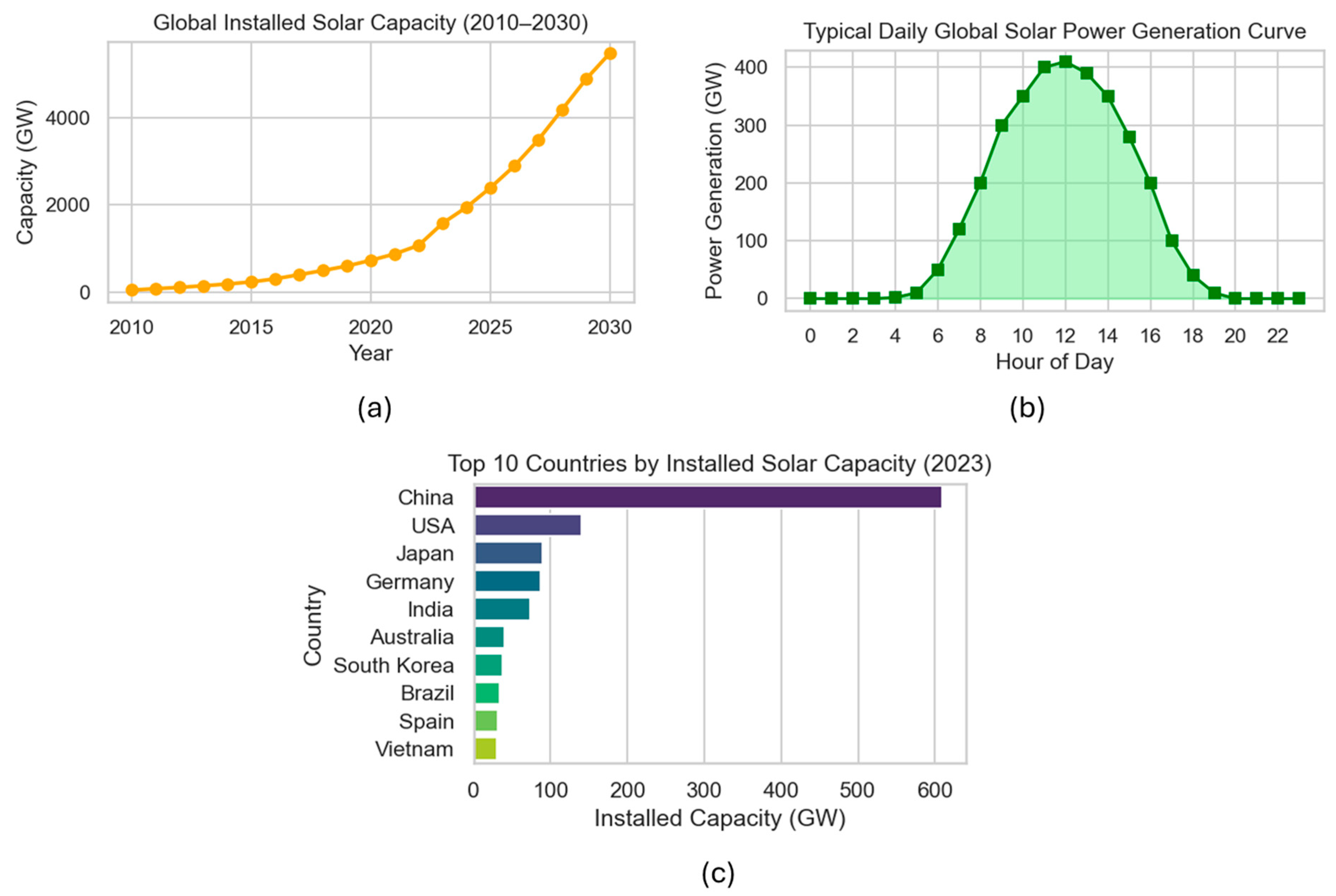

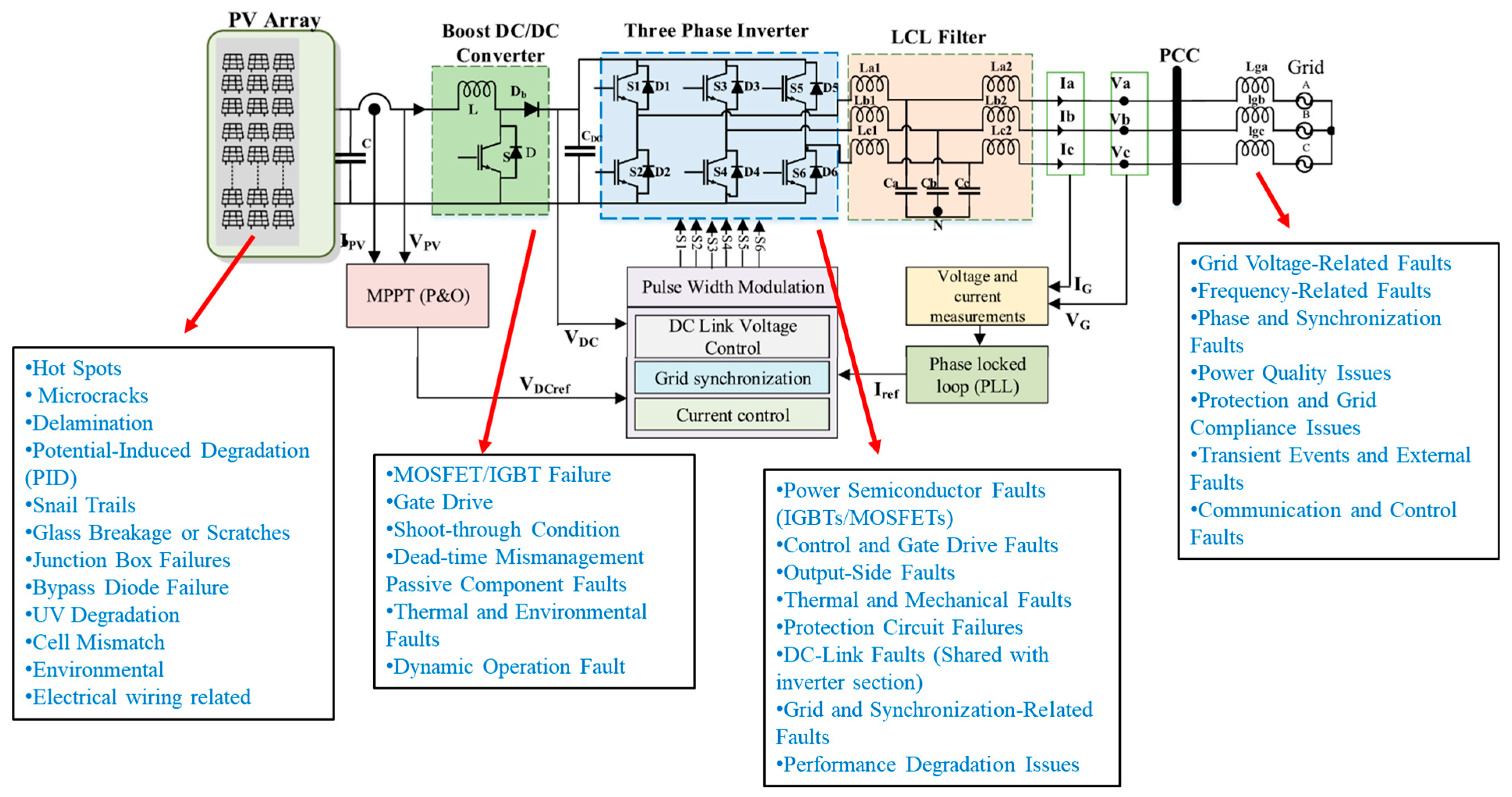
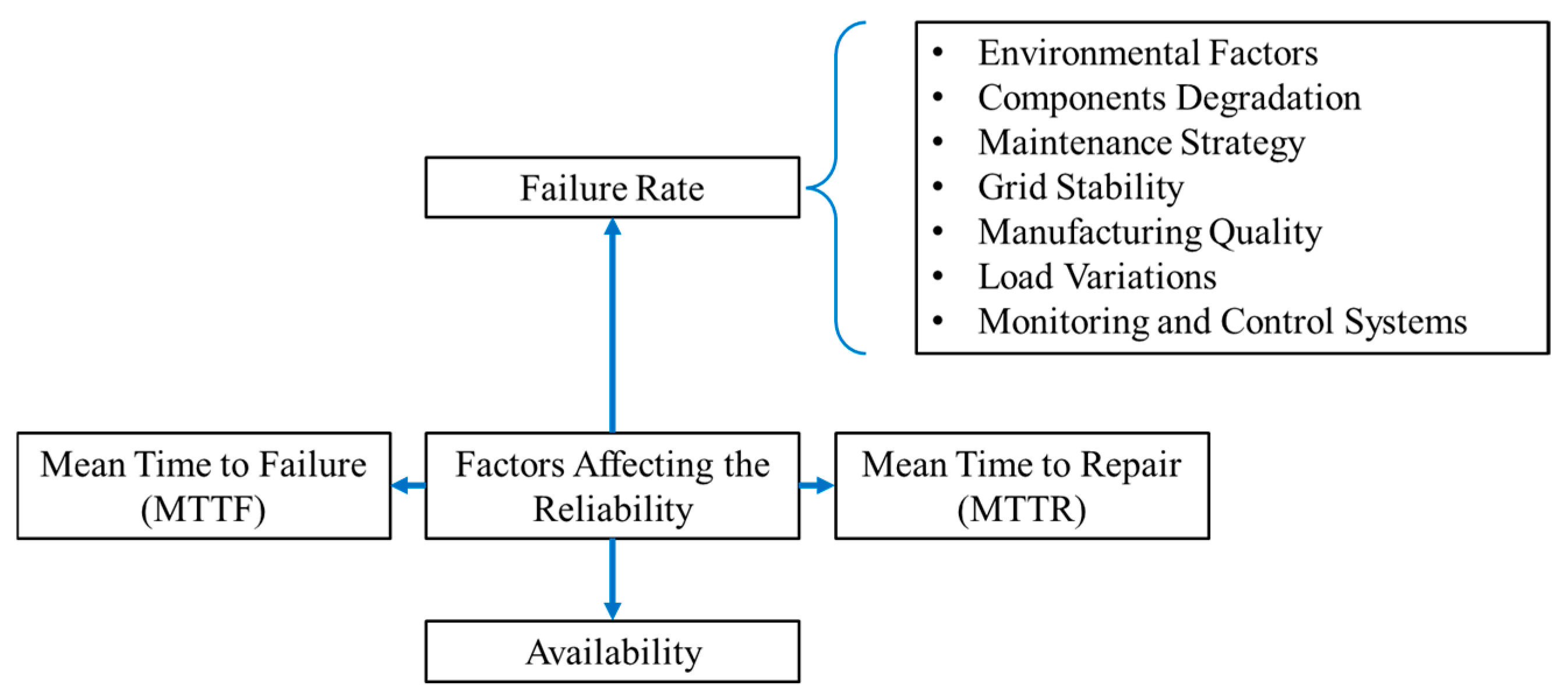

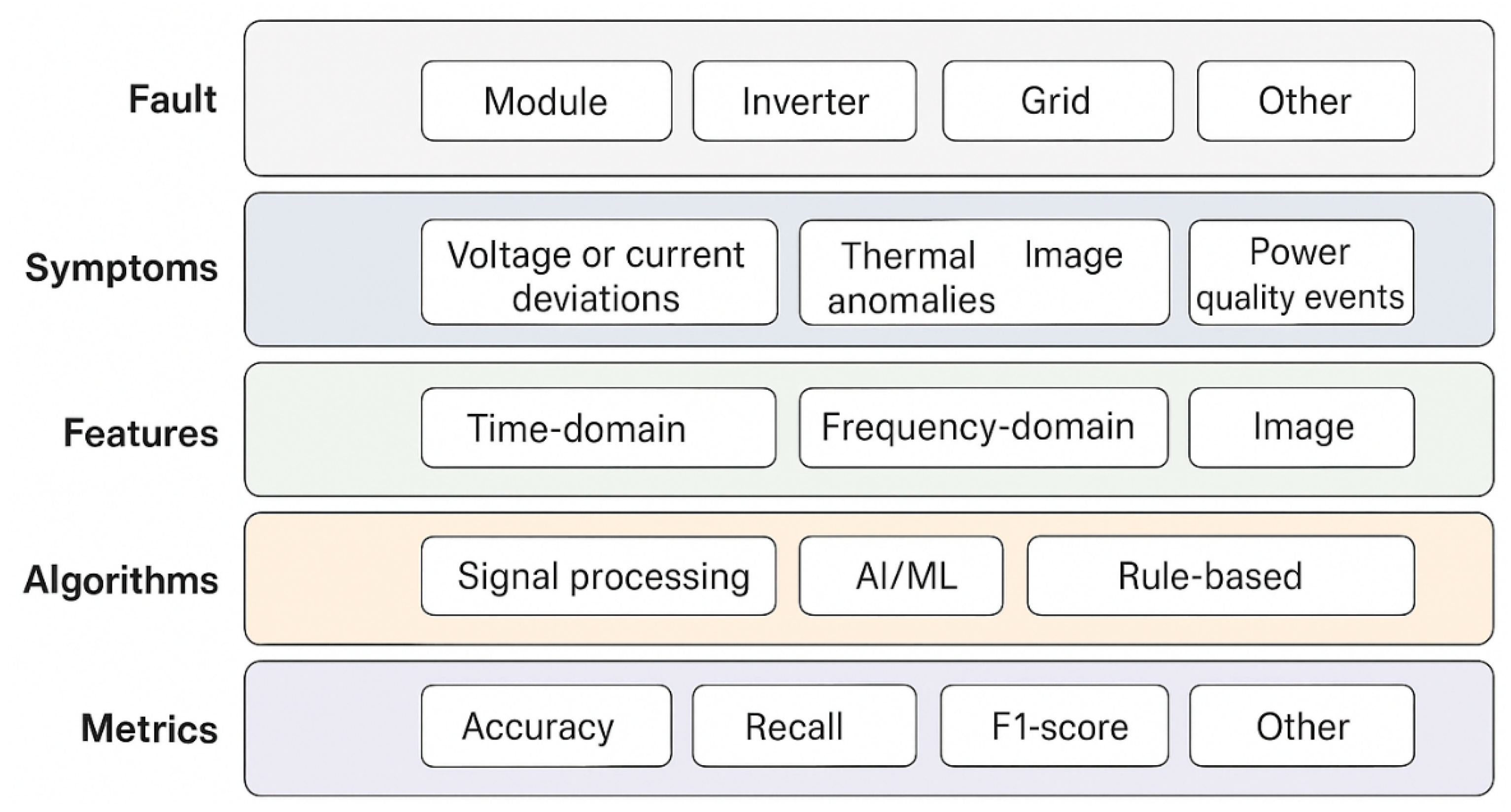
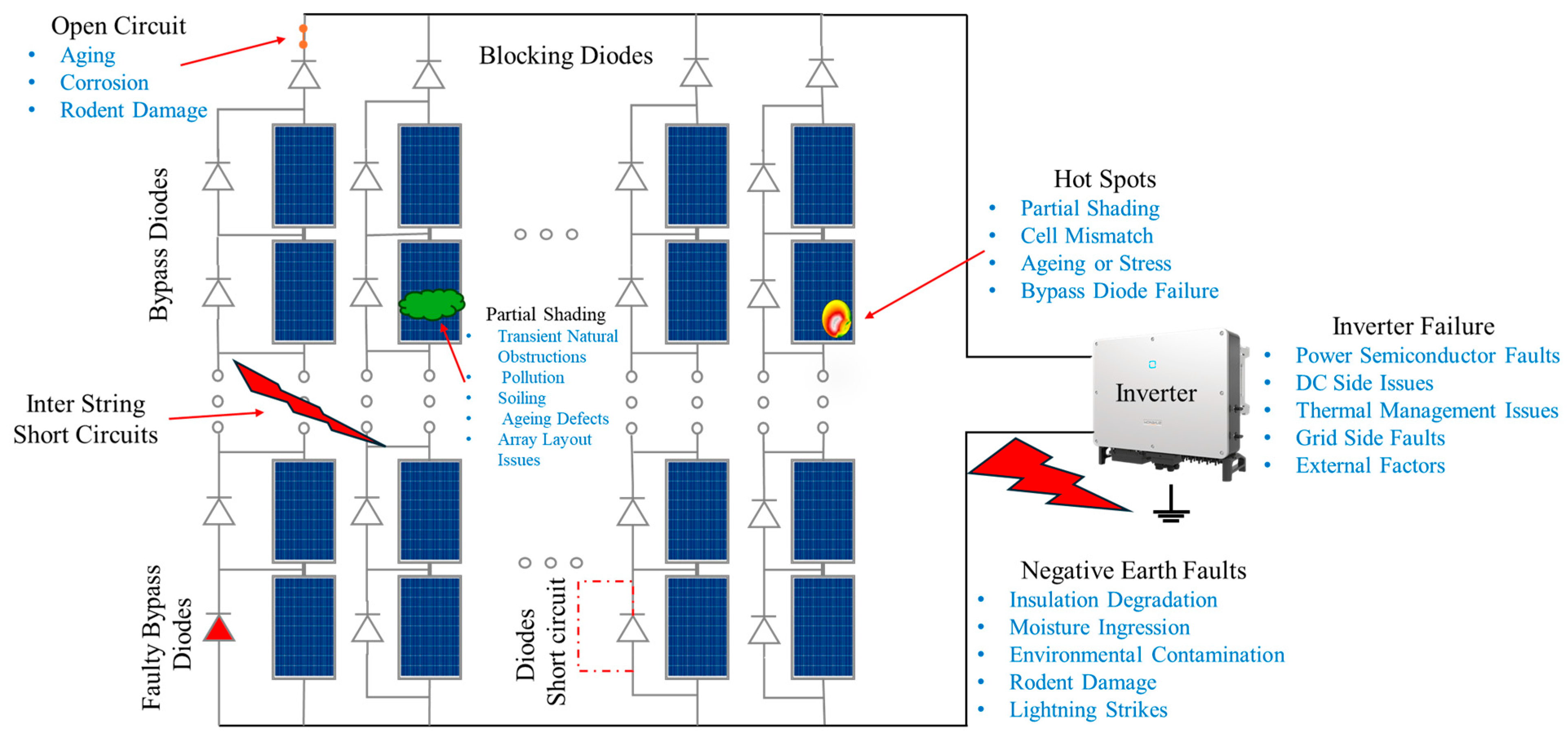

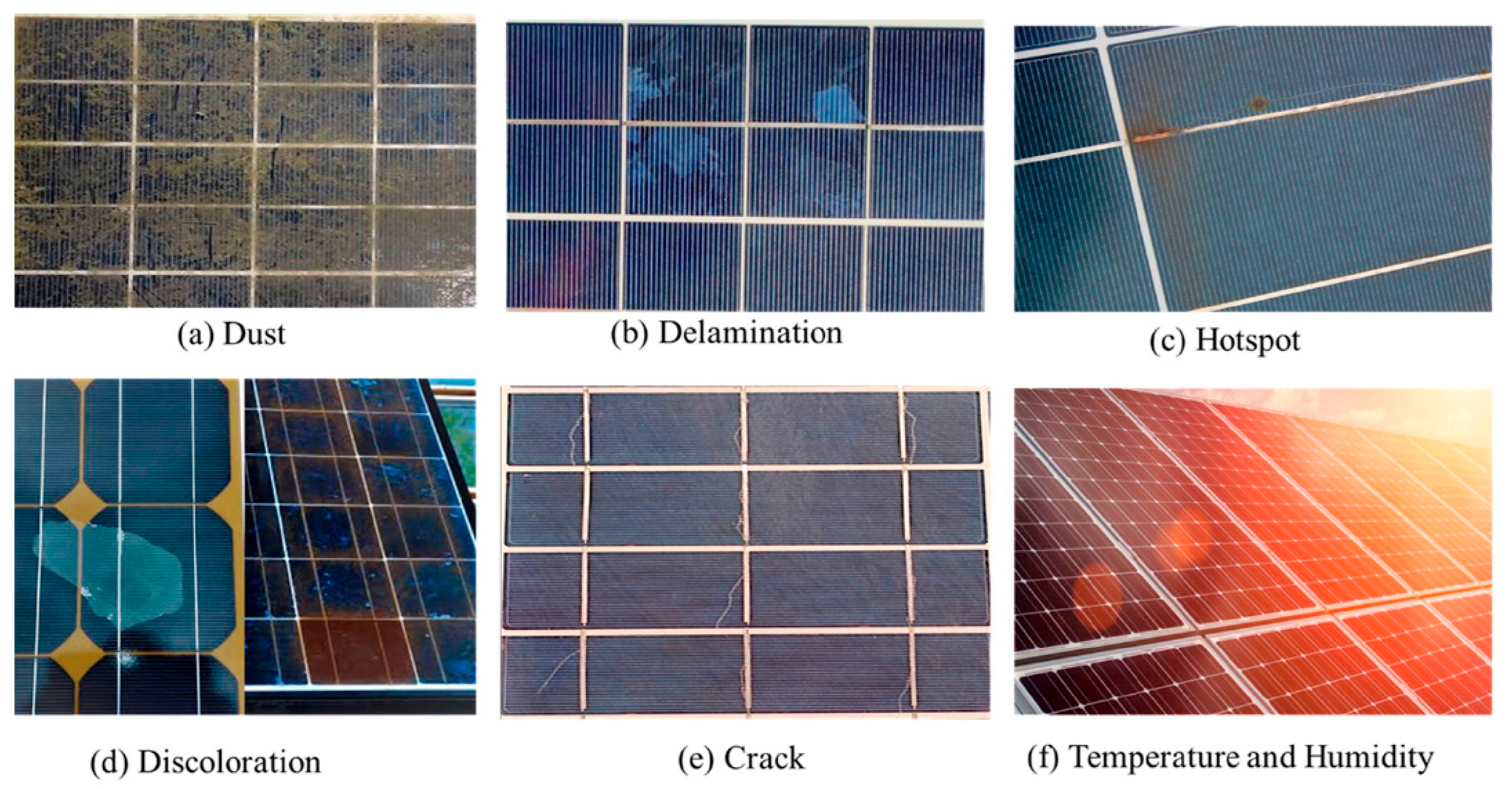


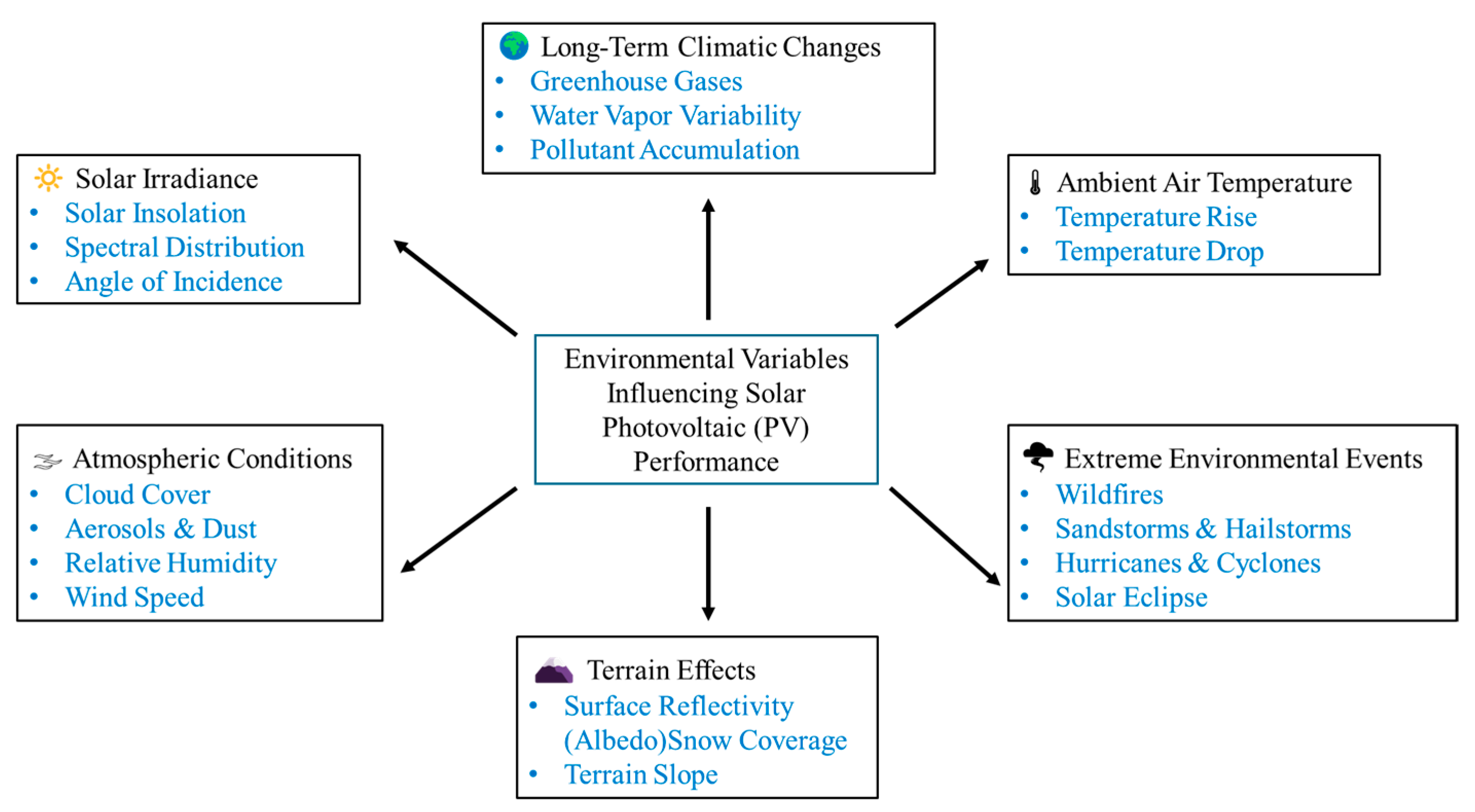
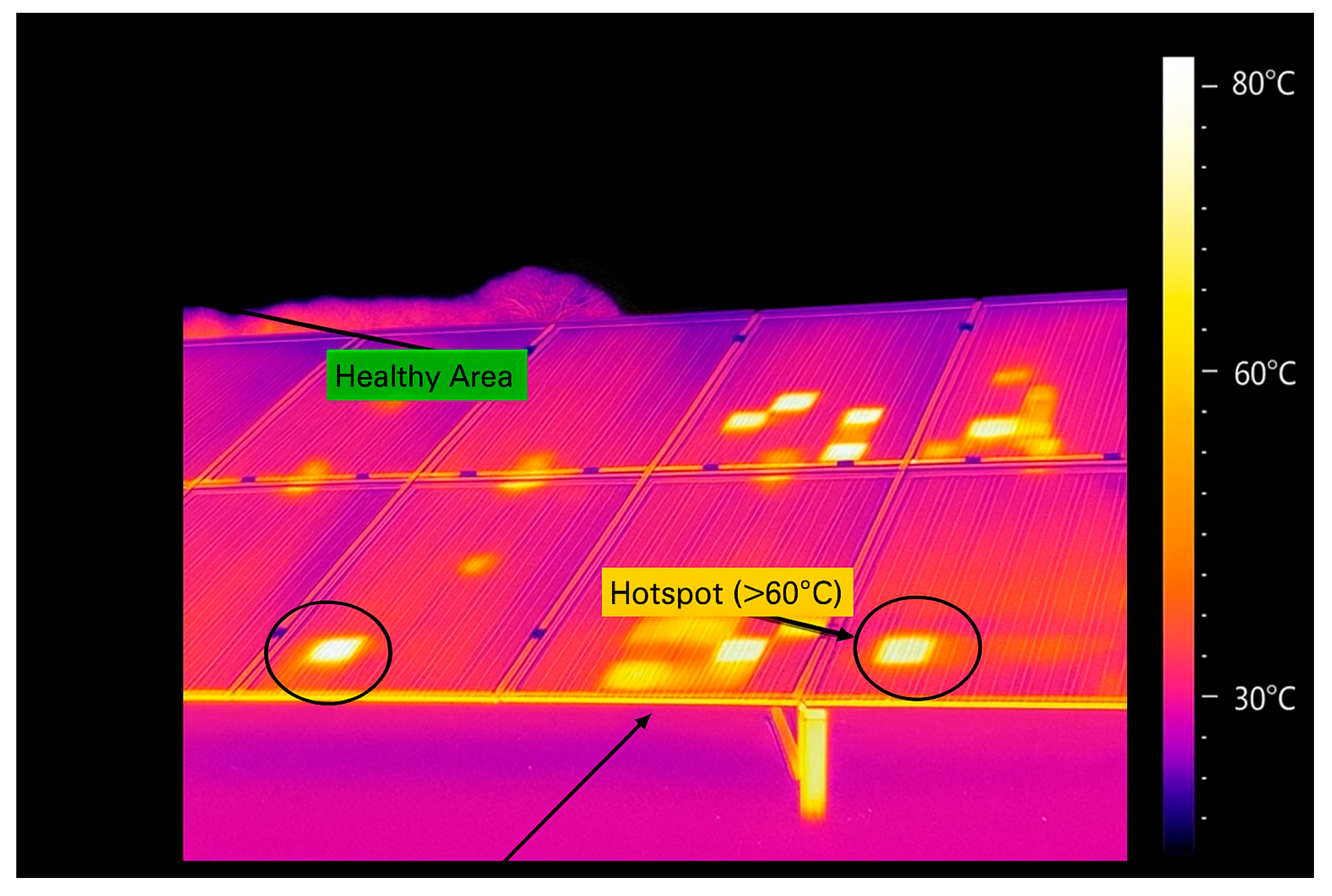
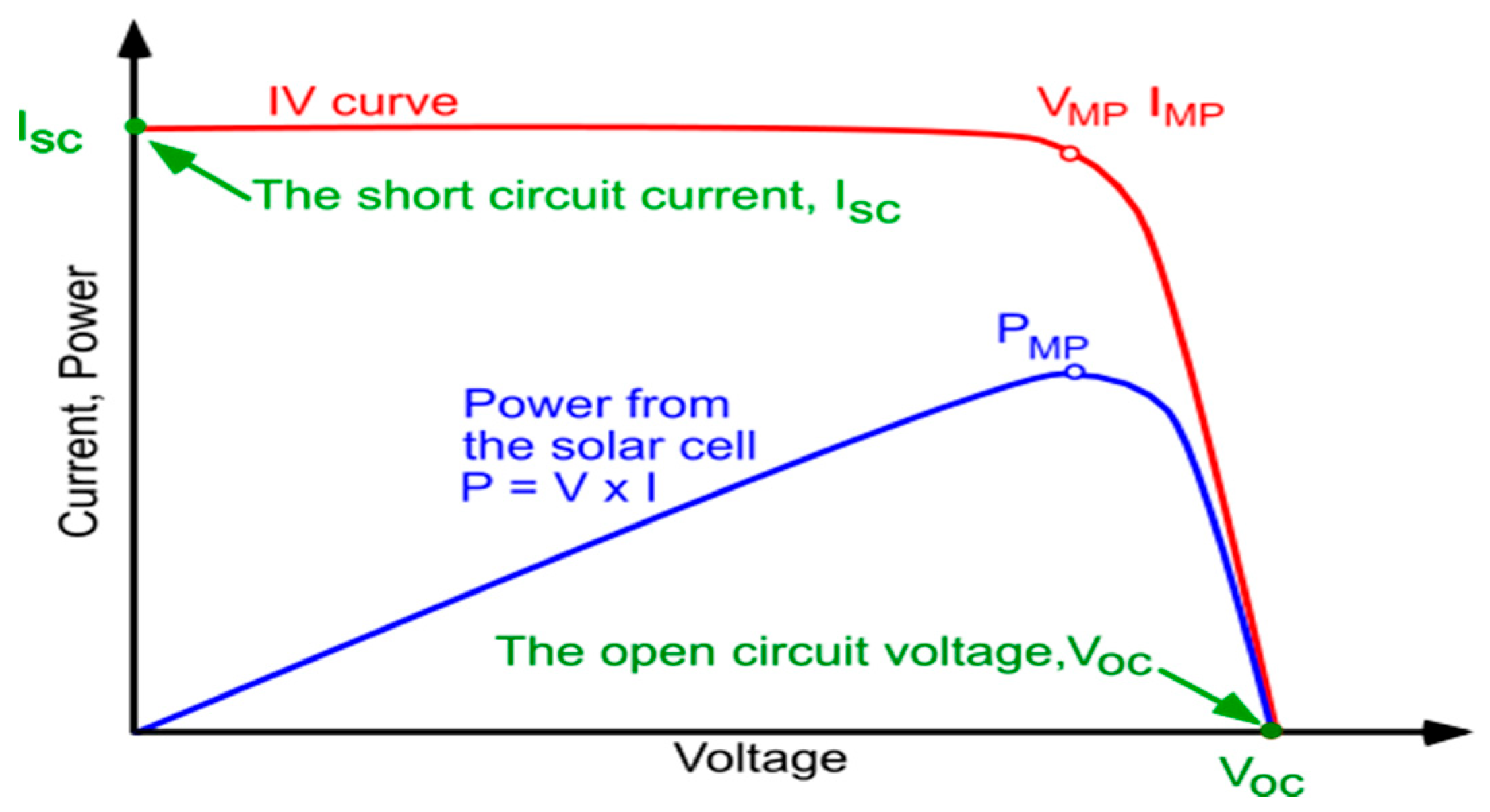

| PV Configuration | Connection Type | Key Components | Common Faults | Typical Monitoring/Detection Method |
|---|---|---|---|---|
| Standalone PV | Isolated (Off-grid) | Panels, charge controller, battery, inverter | Battery degradation, wiring faults, and controller failure | Voltage-current analysis, battery SoC estimation |
| Grid-Connected PV | Grid-synchronized | PV array, inverter, grid interface, protection devices | Inverter failure, synchronization loss, ground faults | FFT, impedance spectroscopy, AI-based signal analysis |
| Hybrid PV | Dual-mode (Grid + Storage) | PV panels, inverter, grid, batteries, auxiliary generator | Inverter mismatch, storage overload, and control instability | SCADA/IoT diagnostics, model-based fault prediction |
| Impact | Description | Potential Solution |
|---|---|---|
| Intermittency and Variability | Solar power generation depends on sunlight, leading to fluctuations in power supply. | Use battery storage, demand response, and hybrid energy systems. |
| Reverse Power Flow | Excess solar energy fed back into the grid can overload transformers and cause instability. | Implement smart grid technology and dynamic voltage control. |
| Harmonic Distortions | Poor-quality inverters introduce harmonic distortions, affecting power quality. | Use high-quality inverters with harmonic filtering. |
| Lack of Inertia and Frequency Instability | Unlike traditional generators, solar PV does not provide rotational inertia, making frequency regulation difficult. | Deploy grid-forming inverters, battery storage, and flexible power plants. |
| Grid Voltage Fluctuations | Sudden changes in solar generation can lead to voltage instability in the grid. | Utilize advanced power electronics and voltage regulation techniques. |
| Impact | Description | Potential Solution |
|---|---|---|
| Grid Voltage Fluctuations | Variations in grid voltage can cause solar inverters to disconnect, leading to energy losses. | Use smart inverters with voltage regulation capabilities. |
| Frequency Variations | Grid frequency instability affects inverter operation, sometimes forcing PV systems to shut down. | Implement grid-supportive inverters and battery storage. |
| Power Curtailment | Grid operators may limit the amount of solar energy fed into the grid during oversupply periods. | Improve grid flexibility and adopt energy storage solutions. |
| Grid Congestion | High solar penetration can overload transmission lines, restricting energy exports. | Upgrade grid infrastructure and introduce demand-side management. |
| Grid Outages &Disturbances | Grid-tied solar PV systems shut down during blackouts, preventing power supply even when sunlight is available. | Deploy battery storage or implement microgrid capabilities for backup power. |
| Technique | Attributes | Pros | Cons | References |
|---|---|---|---|---|
| Machine Learning (ML) | Historical data, supervised, and unsupervised learning | High accuracy in fault detection Real-time adaptability Handles complex fault patterns | Requires extensive training data Computationally intensive Performance is affected by data quality | [67,68,69] |
| Deep Learning (DL) | Neural networks (CNN, RNN, Autoencoders) | Automatic feature extraction Effective for nonlinear faults Early fault detection | Requires large, labeled datasets Complex network tuning Results are difficult to interpret (black box) | [70,71] |
| Support Vector Machines (SVM) | Classification-based method | Effective with small Robust against overfitting Strong generalization capability | Computationally expensive for large datasets Kernel function selection affects the accuracy Sensitive to parameter tuning | [72] |
| Fuzzy Logic | Rule-based decision-making | Robust to noise and uncertainty No labeled data required Easy integration with other models | Requires expert-defined rules Limited generalization to unseen scenarios Complexity increases significantly with large rule sets | [73] |
| Artificial Neural Networks (ANN) | Adaptive learning from data | High accuracy for nonlinear systems Capable of self-learning Identifies complex fault interactions | Prone to overfitting Long training durations Performance highly depends on network architecture | [73,74,75,76] |
| Hybrid AI Models | Combination of ANN, SVM, and Fuzzy Logic | Increased robustness Enhanced fault classification accuracy Combines the advantages of individual models | Complex model design High computational complexity Integration challenges between different methods | [77,78] |
| Electrical Signature Analysis (ESA) | Voltage, current waveform analysis | High sensitivity to electrical anomalies Real-time monitoring capability Non-invasive fault detection | Requires high-quality sensors Susceptible to signal noise interference Limited effectiveness for mechanical faults | [79] |
| FFT-Based Spectral Analysis | Frequency spectrum analysis | Effective for inverter-side diagnostics Capable of detecting periodic faults An established and reliable method | Computationally demanding Less effective for transient or intermittent faults Expert interpretation required | [71] |
| Wavelet Transform (WT) Analysis | Signal decomposition for transient faults | Effective for transient fault detection Good time-frequency localization of faults Useful with non-stationary signals | High computational complexity Proper wavelet function selection is critical Expert knowledge is required for interpretation | [76] |
| Principal Component Analysis (PCA) | Dimensionality reduction | Efficient handling of large datasets Reduces redundancy and noise Simplifies visualization and interpretation | Requires careful data preprocessing Potential loss of critical information Less effective alone, usually combined with other methods | [67] |
| Thermal Imaging | Temperature anomaly detection | Quick and non-invasive method Effective hotspot identification Applicable in real-time monitoring scenarios | Environmental dependency (e.g., cloud cover) Detects only surface-level defects The high initial cost of quality equipment | [75] |
| Electroluminescence Imaging | Infrared emission imaging for defects | High precision in defect localization Capable of detecting micro-cracks and cell degradation Functional even in dark conditions | Requires specialized, expensive equipment Cannot operate effectively under bright ambient conditions Time-consuming for large-scale inspection | [76] |
| Infrared (IR) Imaging | Overheating and defect visualization | Effective visualization of hidden defects Quick and non-contact inspection Detect multiple defect types simultaneously | Expensive for large-scale deployment Limited depth penetration capability Sensitive to environmental temperature variations | [21,80,81] |
| UV Fluorescence Imaging | Defective encapsulation detection | Enables early detection High sensitivity to encapsulation faults Effective for preventive maintenance | Requires UV-sensitive specialized cameras Limited practical deployment in daylight High operational expertise needed |
| I-V Curve Analysis | Current–voltage characteristics analysis | Effective module-level diagnostics Sensitive to various electrical defects Quick assessment in stable conditions | Requires stable environmental conditions Less effective for intermittent issues Sensor accuracy significantly impacts results | [82,83,84] |
| Kalman Filtering | Recursive anomaly estimation | Excellent tracking of dynamic faults Reduces noise measurement effectively Suitable for real-time diagnostic scenarios | Sensitivity to modeling inaccuracies High computational cost in large systems Requires precise initial parameter estimation | [85] |
| Bayesian Networks | Probabilistic fault detection | Effectively manages uncertainty and incomplete data Robust probabilistic reasoning capability Clear probabilistic interpretation of results | Computational complexity is high for large networks Sensitive to incorrect prior probabilities Model design and structure selection are critical | [73] |
| State Estimation Methods | Mathematical modeling of system health | Early detection of system degradation Predictive capability for maintenance planning Good accuracy if the model parameters are accurate | Requires highly accurate system parameters Limited performance in dynamic environments Complex mathematical modeling | [48] |
| Markov Models | Long-term degradation prediction | Effective for reliability and maintenance planning Good for modeling degradation over time Predictive insights into future system states | Extensive historical data requirement Assumes stationary transition probabilities Computationally intensive for large state spaces | [68] |
| Fault Type | Description | Causes | Impact |
|---|---|---|---|
| Hot spots | Localized overheating in solar cells | Shading, defective bypass diodes, and soldering defects | Decreased efficiency, potential fire hazard |
| Cell Cracks | Micro-cracks in silicon cells reduce power output | Manufacturing defects, thermal cycling, and mechanical stress | Increased series resistance and reduced power generation |
| Potential-Induced Degradation (PID) | Performance loss due to leakage currents | High system voltage, humidity, and poor grounding. | Reduced power output over time |
| Delamination and Encapsulation Failure | The peeling of module layers causes water ingress | Poor material quality, UV exposure, and humidity | Accelerated degradation, electrical insulation loss |
| Connector and Junction Box Failure | Lose or broken connections lead to open circuits | Poor installation, thermal cycling, and water ingress | Reduced power delivery, increased resistance |
| Fault Type | Description | Causes | Impact |
|---|---|---|---|
| Open Circuit Faults | Interruption in the current flow due to a broken connection | Loose connectors, broken wires, and a faulty junction box | Power loss in affected modules or strings |
| Short Circuit Faults | An unintended connection between conductors causes excessive current flow | Insulation failure, moisture ingress, damaged cables | Overheating, component damage, fire risk |
| Ground Faults | Leakage of current to the ground, causing the imbalance | Damaged insulation, improper grounding, and moisture | Risk of electric shock, inverter shutdown, and fire hazard |
| Arc Faults | High-temperature plasma discharge in broken conductors | Loose connections, corroded terminals, damaged cables | Fire hazard, increased electrical losses |
| Fault Type | Description | Causes | Impact |
|---|---|---|---|
| Switching Device Failures | Failure of MOSFETs, IGBTs, or diodes in the inverter | Thermal stress, high voltage spikes, and aging | Power loss, inverter shutdown, grid instability |
| Overheating | Excessive temperature rise leads to component degradation. | Poor ventilation, high ambient temperature, and overloads | Efficiency loss, permanent damage to components |
| Capacitor Aging | Electrolytic capacitor failure due to aging | High ripple current, thermal stress | Inverter Instability reduces efficiency |
| Control Circuit Malfunction | Failure in microcontrollers, sensors, or software algorithms | EMI interference, software bugs, and hardware damage | Erratic inverter operation, poor grid synchronization |
| Fault Type | Description | Causes | Impact |
|---|---|---|---|
| Islanding | The PV system continues generating power even when the grid is down | Improper anti-islanding protection, grid failure | Safety hazards, damage to appliances, and utility workers |
| Voltage Imbalances | Unequal voltage in different phases of the grid | Unbalanced loads, grid faults, poor power quality | Efficiency reduction, inverter malfunction |
| Frequency Shifts | Deviation of the grid frequency from nominal values (50/60 Hz) | Grid disturbances, over-generation, and poor inverter response | Inverter tripping, grid instability, and power losses |
| Fault Type | Description | Causes | Impact |
|---|---|---|---|
| Soiling and Dust Accumulation | Dust, dirt, and bird droppings block sunlight | Lack of cleaning, industrial pollution | Reduced energy yield, higher maintenance costs |
| Shading Effects | Partial shading reduces module efficiency. | Trees, buildings, cloud cover, module mismatch | Decreased power output, hotspot formation |
| Hail and Weather Damage | Physical damage from extreme weather conditions | Hailstorms, heavy rain, snow, and wind pressure | Module breakage, reduced efficiency, system failure |
| Corrosion &Rusting | Degradation of metal components | Humidity, saltwater exposure, and poor-quality materials | Structural weakness, electrical failures |
| Diagnostic Domain | Methodology | Key Principle | Advantages | Limitations |
|---|---|---|---|---|
| Electrical Analysis | I–V and P–V curve tracing | Deviation in the curve shape indicates faults | Simple, direct measurement | Requires a shutdown for precise measurement |
| FFT and harmonic analysis | Frequency-domain change under fault | Detects inverter/grid faults | Needs a high sampling rate | |
| Impedance spectroscopy | Frequency response deviation | Sensitive to early degradation | Complex instrumentation | |
| Thermal/optical imaging | Infrared thermography | Hotspots show thermal anomalies | Non-contact, field-applicable | Needs controlled lab conditions |
| Electroluminescence (EL) | Emission defects under bias | High accuracy for micro-cracks | Needs a large labeled dataset | |
| Data-driven/AI-based | Machine learning (SVM, ANN, CNN, LSTM) | Pattern recognition from historical data | High automation and scalability | Needs a large labeled dataset |
| SCADA/IoT-based monitoring | Continuous condition data from sensors | Real-time analytics and alarms | Sensor calibration and communication reliability are required. |
| Approach | Key Features | Advantages | Limitations |
|---|---|---|---|
| Visual Inspection | Manual checks for physical damage | Simple and cost-effective | Time-consuming and labor-intensive |
| Infrared Thermography | Identifies hotspots and defective cells | Non-invasive and accurate | Requires thermal imaging equipment |
| I-V Curve Tracing | Assesses module performance | Provides electrical health insights | Requires specialized instruments |
| Ground Fault Detection | Detects insulation failures | Enhances safety | May not detect minor faults |
| AI-Based Fault Detection | Uses ML algorithms for analysis | High accuracy and automation | Requires large datasets for training |
| Digital Twins | Virtual model for real-time monitoring | Predictive and proactive | High computational requirements |
| IoT-Based Monitoring | Sensors for continuous data collection | Real-time fault detection | Internet dependency |
| Cloud-Based Analytics | Remote fault diagnosis | Scalable and efficient | Data privacy concerns |
| Strategy/Approach | Key Features/Examples | Advantages/Benefits | Limitations/Challenges |
|---|---|---|---|
| Fault Diagnosis and Predictive Maintenance | Visual inspection, infrared thermography, I-V curve tracing, ground fault detection, AI-based detection, IoT/cloud analytics, digital twins | Improved fault detection, predictive capability, and lower downtime | Manual methods are time-consuming; AI/IoT requires high-quality data and infrastructure |
| Design Improvements | High-quality materials, micro inverter adoption, advanced cooling (liquid/air), fault-tolerant architectures | Reduces wear and tear, prevents overheating, and minimizes single-point failures | Higher initial investment and complexity |
| Protection Mechanisms | Anti-islanding protection, surge protective devices, fault current limiters, and grounding | Prevents unsafe islanding, reduces lightning/surge damage, and mitigates short-circuit risks | Requires proper calibration and investment in protective devices |
| Maintenance Strategies | Proactive (predictive/condition-based) vs. reactive | Proactive: failure prevention, long-term cost savings; Reactive: lower initial cost | Proactive: requires monitoring investment; Reactive: leads to costly failures and outages |
| Future Research Directions | AI-driven fault detection, Blockchain-based energy transactions, and digital twins | Enhanced monitoring, security, transparency, and optimization of O&M | High computational demand, early-stage adoption |
| Fault/Degradation Type | Typical Energy or PR Loss (%) | 95% Confidence Interval | References |
|---|---|---|---|
| Soiling (dust accumulation) | 3–10 | ±2 | [70,71,102,108] |
| Potential-Induced Degradation (PID) | 5–20 | ±4 | [56,83,92,105] |
| Hotspot faults | 2–5 | ±1 | [61,106,107] |
| Bypass diode failure | 1–3 | ±1 | [52,101] |
| Connector/combiner faults | 2–6 | ±2 | [77,80,88] |
| Diagnostic Technique | Mean Accuracy (%) | Standard Deviation | Confidence Interval (95%) |
|---|---|---|---|
| Infrared (IR) Thermography | 93.4 | 2.5 | 91–96 |
| Electroluminescence (EL) Imaging | 96.2 | 1.8 | 94–98 |
| Electrical-Signal Analysis | 90.1 | 3.0 | 87–93 |
Disclaimer/Publisher’s Note: The statements, opinions and data contained in all publications are solely those of the individual author(s) and contributor(s) and not of MDPI and/or the editor(s). MDPI and/or the editor(s) disclaim responsibility for any injury to people or property resulting from any ideas, methods, instructions or products referred to in the content. |
© 2025 by the authors. Licensee MDPI, Basel, Switzerland. This article is an open access article distributed under the terms and conditions of the Creative Commons Attribution (CC BY) license (https://creativecommons.org/licenses/by/4.0/).
Share and Cite
Kull, K.; Asad, B.; Khan, M.A.; Naseer, M.U.; Kallaste, A.; Vaimann, T. Faults, Failures, Reliability, and Predictive Maintenance of Grid-Connected Solar Systems: A Comprehensive Review. Appl. Sci. 2025, 15, 11461. https://doi.org/10.3390/app152111461
Kull K, Asad B, Khan MA, Naseer MU, Kallaste A, Vaimann T. Faults, Failures, Reliability, and Predictive Maintenance of Grid-Connected Solar Systems: A Comprehensive Review. Applied Sciences. 2025; 15(21):11461. https://doi.org/10.3390/app152111461
Chicago/Turabian StyleKull, Karl, Bilal Asad, Muhammad Amir Khan, Muhammad Usman Naseer, Ants Kallaste, and Toomas Vaimann. 2025. "Faults, Failures, Reliability, and Predictive Maintenance of Grid-Connected Solar Systems: A Comprehensive Review" Applied Sciences 15, no. 21: 11461. https://doi.org/10.3390/app152111461
APA StyleKull, K., Asad, B., Khan, M. A., Naseer, M. U., Kallaste, A., & Vaimann, T. (2025). Faults, Failures, Reliability, and Predictive Maintenance of Grid-Connected Solar Systems: A Comprehensive Review. Applied Sciences, 15(21), 11461. https://doi.org/10.3390/app152111461








